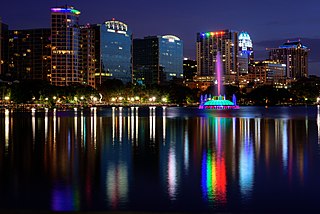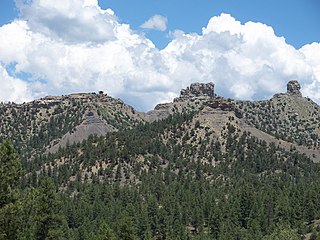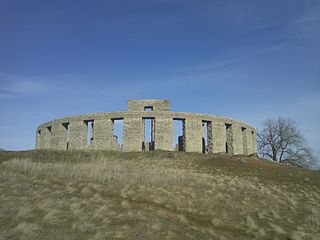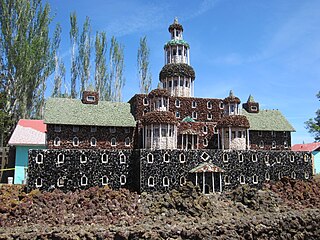
Osceola County is a county located in the central portion of the U.S. state of Florida. As of the 2020 census, the population was 388,656. Its county seat is Kissimmee. Osceola County is included in the Orlando–Kissimmee–Sanford, Fla. Metropolitan Statistical Area.

Kissimmee is the largest city and county seat of Osceola County, Florida, United States. As of the 2020 census, the population was 79,226. It is a Principal City of the Orlando-Kissimmee-Sanford, Florida, Metropolitan Statistical Area, which had a 2020 population of 2,673,376. The Census Bureau defines an urban area with Kissimmee as the principal city, which is separated from the Orlando urban area. The Kissimmee–St. Cloud, FL urban area had a 2020 population of 418,404, making it the 100th largest in the United States.

Coral Castle is an oolite limestone structure created by the Latvian-American eccentric Edward Leedskalnin (1887–1951). It is located in unincorporated territory of Miami-Dade County, Florida, between the cities of Homestead and Leisure City. The structure comprises numerous large stones, each weighing several tons, sculpted into a variety of shapes, including slab walls, tables, chairs, a crescent moon, a water fountain and a sundial. It is currently a privately operated tourist attraction. Coral Castle is noted for legends surrounding its creation that claim it was built single-handedly by Leedskalnin using reverse magnetism or supernatural abilities to move and carve the stones.

The Orlando metropolitan area, also known as Central Florida, Greater Orlando, Metro Orlando, as well as for U.S. Census purposes as the Orlando–Kissimmee–Sanford, Florida Metropolitan Statistical Area, is a metropolitan area in the central region of the U.S. state of Florida. Its principal cities are Orlando, Kissimmee and Sanford. The U.S. Office of Management and Budget defines it as consisting of the counties of Lake, Orange, Osceola, and Seminole.

Roosevelt Park is a 217-acre park located in central east Edison, New Jersey, at Parsonage Road and U.S. Route 1, just west of Menlo Park Mall. Established in 1933 in what was then Raritan Township, the park is considered the oldest park in the Middlesex County Park System. It is owned and operated by the county government.

Salisbury National Cemetery is a United States National Cemetery located in the city of Salisbury, in Rowan County, North Carolina. It was established at the site of burials of Union soldiers who died during the American Civil War while held at a Confederate prisoner of war camp at the site.

Chimney Rock National Monument is a 4,726-acre (1,913 ha) U.S. National Monument in San Juan National Forest in southwestern Colorado which includes an archaeological site. This area is located in Archuleta County, Colorado, between Durango and Pagosa Springs, and is managed for archaeological protection, public interpretation, and education. The Chimney Rock Archaeological Site has been listed on the National Register of Historic Places since 1970. U.S. President Barack Obama created Chimney Rock National Monument by proclamation on September 21, 2012, under authority of the Antiquities Act.

The Osceola Library System is a public library system serving Osceola County in Central Florida. The main branch is the Hart Memorial Central Library in historic downtown Kissimmee. The system has large branch locations in St. Cloud, Buenaventura Lakes, Poinciana, and West Osceola, as well as a small branch in Kenansville.

Paul Bunyan and Babe the Blue Ox are the names of a pair of large statues of the American folk hero Paul Bunyan and his ox, located in Bemidji, Minnesota. This roadside attraction has been listed on the National Register of Historic Places since 1988.

Munson Valley Historic District is the headquarters and main support area for Crater Lake National Park in southern Oregon. The National Park Service chose Munson Valley for the park headquarters because of its central location within the park. Because of the unique rustic architecture of the Munson Valley buildings and the surrounding park landscape, the area was listed as a historic district on the National Register of Historic Places (NRHP) in 1988. The district has eighteen contributing buildings, including the Crater Lake Superintendent's Residence which is a U.S. National Historic Landmark and separately listed on the NRHP. The district's NRHP listing was decreased in area in 1997.

The Rahr–West Art Museum is an art museum in Manitowoc, Wisconsin. It is located in the Joseph Vilas Jr. House, which is listed on the National Register of Historic Places. The house is a significant example of Queen Anne style architecture in the United States.

The Maryhill Stonehenge is a replica of England's Stonehenge located in Maryhill, Washington, United States. It was commissioned in the early 20th century by the wealthy entrepreneur Sam Hill, and dedicated on July 4, 1918 as a memorial to the people who had died in World War I.

The Chris Jorgensen Studio is a one-room log building, built in 1904 as an artist's studio for Chris Jorgensen in the Yosemite Valley. Jorgensen, an instructor and assistant director of the California School of Fine Arts, arrived in Yosemite in the 1890s. Jorgensen studied and depicted local Native Americans from 1899, collecting native basketwork. The National Park Service acquired the Jorgensen Studio in 1919, calling it the Yosemite Museum. Jorgensen donated his basket collection to the museum in 1923. Jorgensen's widow, Angela Ghiardelli, donated many of Jorgensen's works to the museum following his death in 1935.

The Bemidji Carnegie Library is a former library building in Bemidji, Minnesota, United States. It was built as a Carnegie library in 1909 and housed the city's public library until 1961. It was listed on the National Register of Historic Places in 1980 for its local significance in the themes of architecture and education. It was nominated for being a well-preserved example of a Carnegie library and of public Neoclassical architecture.

Petersen Rock Garden, formerly Petersen's Rock Garden and also known as the Petersen Rock Gardens, is a rock garden and museum on 4 acres (1.6 ha), located between the cities of Bend and Redmond in Deschutes County, Oregon, United States. Rasmus Petersen, a Danish immigrant who settled in Central Oregon in the early 1900s, began constructing the garden in 1935 using rocks he found within an 85-mile (137 km) radius of his family home. Petersen constructed detailed miniature castles, churches and other small buildings and monuments from a variety of rock types. He incorporated other design elements such as bridges, water features, and natural landscaping. Petersen worked on the garden until his death in 1952; the garden has remained in his family's care since then. The garden, considered a roadside attraction with novelty architecture, includes roaming peafowl and a museum with a gift shop that sells rocks.

Mount Theodore Roosevelt Monument, also known as the Roosevelt Friendship Monument or Friendship Tower, located in the Black Hills National Forest on the outskirts of Deadwood, Lawrence County, South Dakota, is a 31-foot stone tower, including the six-foot-high platform, honoring Theodore Roosevelt. It was the first tribute to the president's memory and was dedicated July 4, 1919.
The Hart Memorial Central Library is a member of the Osceola Library System. It is the headquarters of the Osceola Library system.

Pine-Hickory Lakes Roadside Parking Area is a wayside rest located along U.S. Highway 169 in Farm Island Township, Aitkin County, Minnesota. It straddles both sides of the highway just north of where it passes between Little Pine Lake on the west and Hickory Lake on the east. It is one of the largest wayside rests developed by the Minnesota Highway Department during the New Deal, at 35 acres (14 ha). Arthur R. Nichols, collaborating with engineer Harold E. Olson, designed the rest area in the National Park Service rustic style. The wayside rest was listed on the National Register of Historic Places in May 2016.

The Morgan Morgan Monument, also known as Morgan Park, is a 1.05-acre (0.4 ha) roadside park in the unincorporated town of Bunker Hill in Berkeley County, West Virginia. It is located along Winchester Avenue and Mill Creek. The park features a granite monument that was erected in 1924 to memorialize Morgan Morgan (1688–1766), an American pioneer of Welsh descent, who was among the earliest European persons to settle permanently within the present-day boundaries of West Virginia.

Blair House, also known as The President's Guest House, is an official residence in Washington, D.C., the capital of the United States. The President's Guest House has been called "the world's most exclusive hotel" because it is primarily used as a state guest house to host visiting dignitaries and other guests of the president. Parts of the historic complex have been used for an official residence since the 1940s.

























